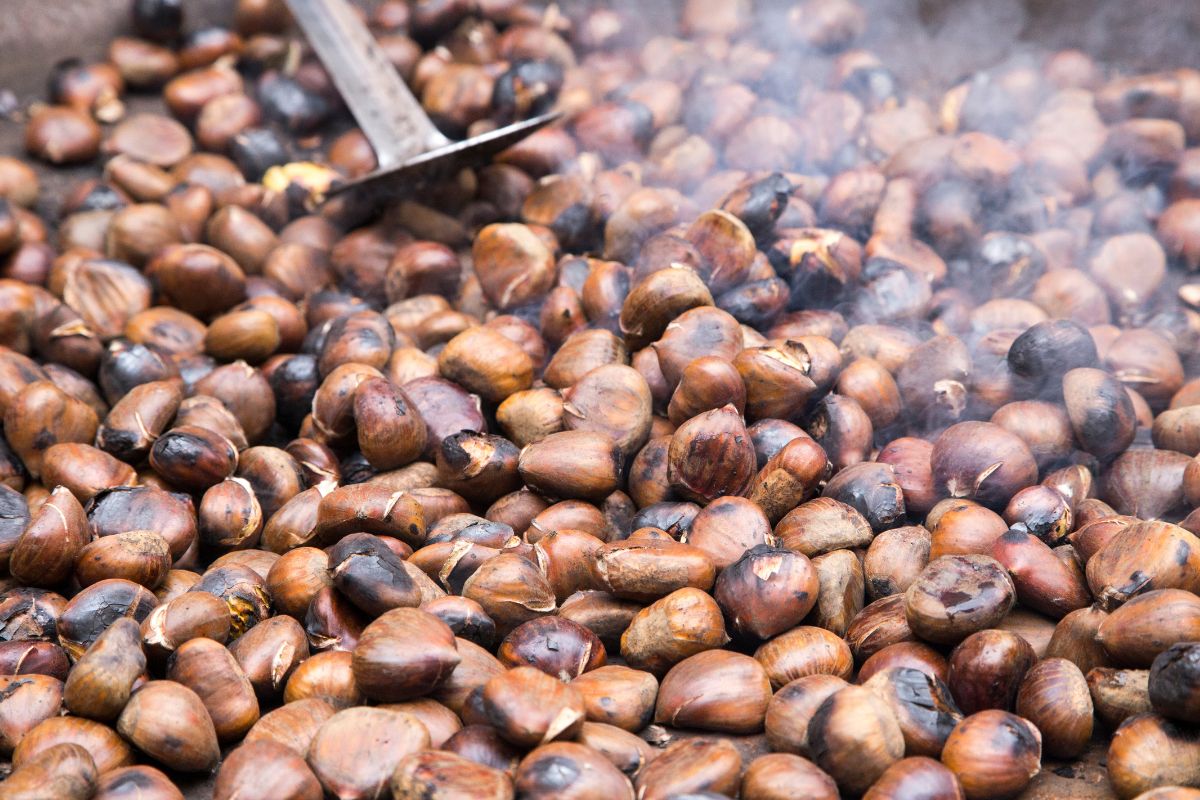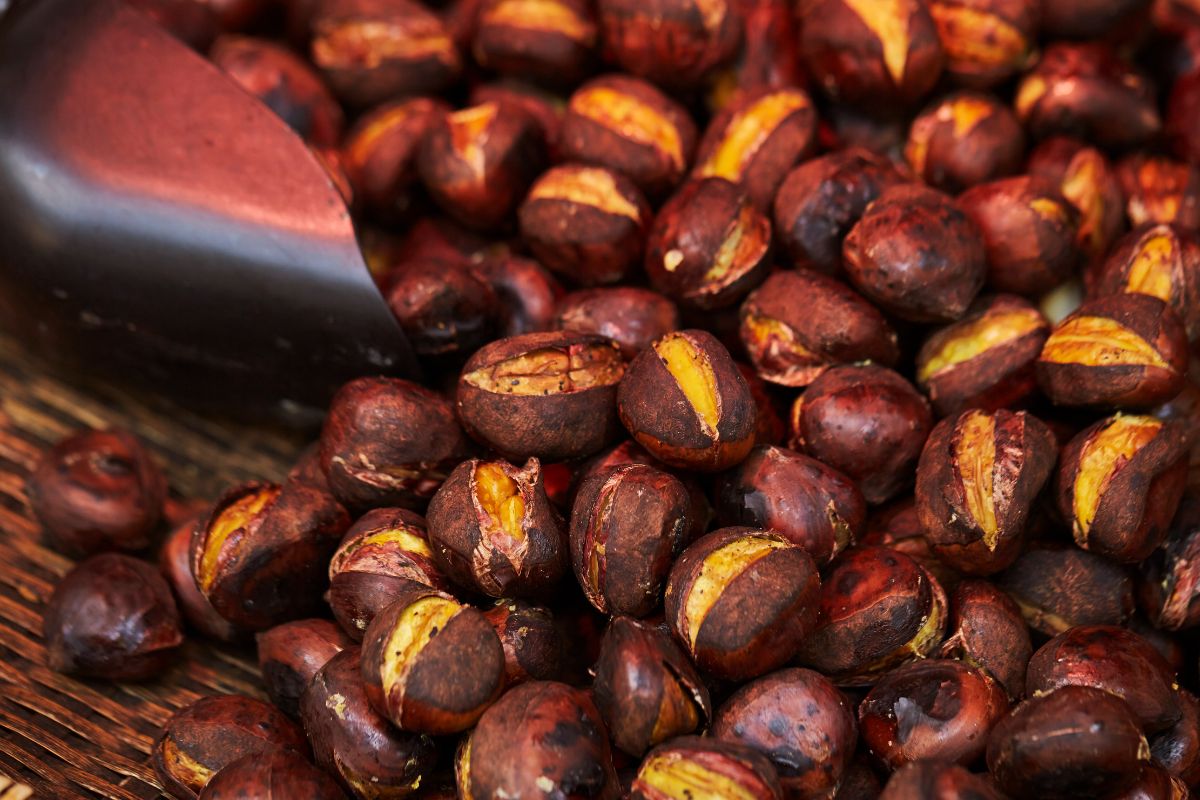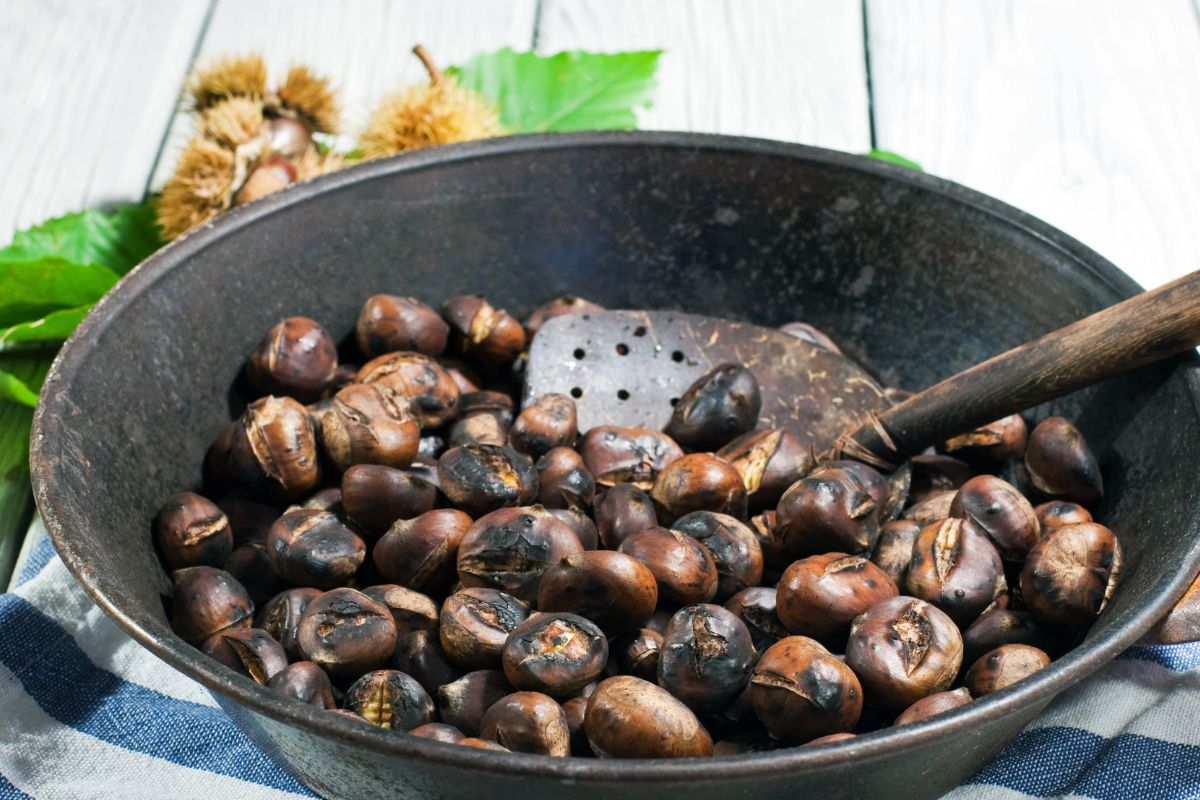What are Chestnuts?
Castanea trees, deciduous trees that thrive in Europe, North America, and Asia, produce chestnuts as their edible fruit. You can learn how to roast chestnuts on fire and enjoy it with your family or friends. They are one of the few nuts, along with hazelnuts, that are fruits rather than seeds.

How to Roast Chestnuts on Fire
Chestnuts Roasting on an Open Fire
Time: 1 hour 22 minutes
Serving Size: 4 servings
Prep Time: 10 minutes
Cook Time: 12 minutes
Soaking Time: 1 hour
Nutritional Facts/Info Per Serving/In Total
Calories: 222 kcal
Carbohydrates: 1.76 ounces (50 grams)
Protein: 0.070 ounces (2 grams)
Fat: 0.03 ounces (1gram)
Saturated Fat: 0.03 ounces (1gram)
Polyunsaturated Fat: 0.03 ounces (1gram)
Monounsaturated Fat: 0.03 ounces (1gram)
Sodium: 2 milligrams (0.002 gram)
Potassium: 549 mg (0.549 gram)
Vitamin A: 29IU
Vitamin C: 46mg (0.046 gram)
Calcium: 22mg (0.022 gram)
Iron: 1mg (0.001 gram)
Equipment Needed
Some crucial tools are necessary if using fire, which we highly recommend making roasting easier and safer.
- Gloves designed for high-heat welding are essential to prevent hand burns when the fire and heat are several hundred degrees. Keep your hands safe.
- Cast iron pans are capable of withstanding high temperatures. Using an open fire pit or a sizable grill is essential due to the cast iron pan’s size and the handle’s presence. Using your fireplace is still an alternative.
- A sharp paring or serrated knife makes scoring the nuts much easier. Scoring the nuts is essential for roasting chestnuts successfully.
Ingredients
- 1 pound (0.454 kilograms) chestnuts
Directions
- Place the flat side of the chestnut down on a cutting surface to begin scoring them. It is best to have the round (also known as the belly) side facing up. If you have a chestnut knife or a sharp paring knife, use that to make a horizontal incision across the rounded side of the chestnut while holding it firmly.
- Rotate the chestnut 90 degrees before making a second X-shaped cut. Try your best to avoid scoring the inside skin as you cut. Keep going with the remaining chestnuts.
- Place scored chestnuts in a bowl with cold tap water, cover them, and let them soak for an hour.
- Prepare the open fire pit or charcoal grill. When the briquettes are ready, scatter them equally to make a flat surface to place the cast-iron skillet. Put a grill grate on top if you have one. Place the cast iron skillet carefully over the hot coals (or grate) and preheat for five to ten minutes.
- Fill the cast iron skillet with chopped chestnuts at once. You should complete this in two batches if they don’t fit in a single layer.
- Depending on the variety of chestnuts you use, they should open up immediately.
- For around 10 to 12 minutes, toss them occasionally while they cook. It’s natural for there to be some smoke coming out. When the outer peel is completely open to reveal the interior yellow nut, they are well-cooked. However, peeling and tasting it is the greatest way to determine when something is ready. It should be ready if it is smooth and silky.
- Put a lid on it for a short period to keep the air inside if it is not entirely roasted after 10 to 12 minutes. However, keep a careful eye on it and check in on it frequently.
- Allow them to cool for a while, and then immediately peel them when they are well-roasted and opened up.
- Let them steam for a few minutes if peeling them is challenging. Place the roasted chestnuts on a tea towel after carefully removing the cast iron skillet from the grill. Create a tiny pouch out of the towel’s edges by gathering them in the center. Allow them to steam for 5 to 10 minutes in the “pouch.” You can also use a paper bag as an alternative. Place the hot, freshly roasted chestnuts inside, roll the bag to contain the steam, and set the bag aside to cool for five to ten minutes.
- While the chestnuts are still hot, transfer them to a tray, and remove the outer shell by carefully pulling back on the scored “X,” peeling away the papery skin and revealing the yellow interior flesh. Use a small, sharp knife to peel away the fuzzy inner skin if you cannot do so by hand while being careful not to sever the yellow nut inside. Throw away the rotten chestnuts with spoiled interiors.
- Eat roasted chestnuts with your favorite herbs or seasonings, or enjoy them on their own.
Notes
Do you have different ideas on how to roast chestnuts on an open fire? Read through the following points to achieve wonderful results.
American and Italian chestnuts are superior for roasting over an open flame. When compared to Chinese chestnuts, they are also simpler. To ensure uniform roasting, try to get chestnuts of comparable size when you go shopping.
The cooking time may differ depending on the chestnut’s type, size, and age. Ten to twelve minutes of roasting produced wonderfully roasted chestnuts.
How should you roast your chestnuts on a gas grill? Set your gas grill to 450 degrees Fahrenheit (232.2 degrees Celsius) for preheating. Score and soak chestnuts according to the recipe’s instructions. Additionally, preheat the cast iron skillet as directed.
You can cover the gas grill but never leave it unattended when cooking. Check it every 1 to 2 minutes, and keep a careful eye on it. The roasting time may be shorter if you use a chestnut roasting pan. To avoid burning, use the earlier advice to determine when something is ready.
An important safety reminder: Being cautious around the fire is obvious, especially if children are present. Stay in the area while the chestnuts are roasting because doing so demands close attention.
Remember to score: Even while it is annoying to score every chestnut, failing to do so could result in a terrifying explosion in your space. Take the time to score each raw chestnut properly because if you don’t, it can explode while roasting.
The ideal approach is a single layer: Avoid packing the pan. Each chestnut should come into contact with the pan’s surface as they roast. To achieve even roasting, flip them with tongs if necessary.
Can I use a fireplace for this? You can, indeed. But for convenience and safety, get a chestnut roaster for your fireplace. You can get two uses out of your investment because most roasters on the market can make popcorn.
Storage: Chestnuts cooked over a fire can stay in the refrigerator for up to 4 days in an airtight container.

Do Chestnuts Pop?
If you roast chestnuts without piercing first, they explode. They will explode like popcorn but only make a mess and not puff as steam builds up inside the nut. Use a paring knife to make a shallow cut through each nut’s “tail” end before cooking to allow the steam to escape safely.
Signs of a Cooked Chestnut
The yellow flesh should ideally be visible as they explode open. Peel the outer shell to perform the first test while not burning your fingers. You’re fine to go if it has a chewy bite and is soft and buttery. Put it back in the skillet and roast it for a few more minutes if it’s still tough.
Where to Buy Chestnuts
When choosing chestnuts for the fall and early winter, seek firm and lustrous ones. Beginning around Thanksgiving in the United States, you can get them in supermarkets, as well as at late-season farm markets and Italian grocers.
Preparing Chestnuts for Roasting
A hard shell encases a soft nut called a chestnut. When cooked, the nut steams because it contains a substantial quantity of moisture. Preparing the chestnut over an open fire is crucial to prevent it from exploding.
The shell normally has one flat side and one rounded side. When purchasing, make sure the nuts have no cuts and are fresh.
Use an X-shaped paring or serrated knife to mark the chestnut’s flat surface. You can cut such that just the interior of the nut casing is visible. As a result, the steam will be able to escape. Making an X that is too large may result in the nut coming out of the shell and burning in the pan as the chestnuts roast and their shells expand. Don’t do that.
How Long to Roast Chestnuts
The size, age, and type of the chestnuts will all affect how long they need to roast. However, roasting over an open flame in a cast-iron skillet typically takes 10 to 12 minutes.
The Taste of Roasted Chestnuts
The flavor of chestnuts roasted in the oven and over an open flame is remarkably similar. They have an extra woody scent, is soft, sweet, and a touch chewy, and have a lovely light char.
Serving and Storing Roast Chestnuts
The most common way to eat chestnuts is to serve them independently. You can also try other ways:
Heat 2 tablespoons of unsalted butter in the cast iron skillet before adding the butter, cinnamon, and sugar drizzle. Once the butter has melted, remove it from the heat and stir in 1/4 teaspoon of ground cinnamon and one tablespoon of coconut sugar (or brown sugar or maple syrup). You can dip or drizzle roasted chestnuts with the mixture.
Rosemary and Butter: If you’d like to take a more savory approach, melt some butter in a cast iron skillet. Then, add a teaspoon of finely chopped fresh rosemary and season it to taste with sea salt and black pepper. Just heat everything enough to melt the butter and combine everything.
Place roasted, peeled chestnuts on a platter and sprinkle the mixture. Alternatively, serve it on the side.
How to Peel Roasted Chestnuts
Isn’t this the million-dollar question? Each chestnut should perfectly open up and be very simple to peel. If that’s the case, pull back on the scored X to peel off the inner and outer papery skins, then immediately enjoy.
Let them steam for a few minutes if they are not fully open, and peeling is difficult. To do this:
When the chestnuts are completely roasted, carefully take the cast iron skillet off the grill and place it on a tea towel. Create a tiny pouch out of the towel’s edges by gathering them in the center. Allow them to steam for 5 to 10 minutes in the “pouch.” In addition, brown paper bags can replace kitchen towels.
Peel and cool while the chestnuts are still hot; transfer the roasted nuts to a tray (or a baking sheet) and gently peel them along the “X,” exposing the golden interior flesh behind the papery exterior. If you cannot peel the inner skin off by hand, take care not to pierce the yellow nut within while you work.
Throw away the bad chestnuts with spoiled interiors. And lastly, take your time when peeling chestnuts. It is typical for some to break and for others to be challenging to peel. It’s all a part of enjoying yourself while working by the fire.
TPI’s Top Chestnut Roasting Tips
When shopping for whole chestnuts, it can be difficult to determine what you will eat because they have an exterior covering that obscures their appearance. The following are some helpful hints and suggestions on the selection of chestnuts:
- Feel the weight. Pick a chestnut that has a substantial weight relative to its size. You shouldn’t bother with it if it has a hollow or dried-out feeling. However, given that it is all about the weight-to-size ratio, even if the chestnut is large and seems to be as hefty as one would anticipate, there is no assurance that it would be tasty. Make decisions based on what seems most reasonable, and pick up a few extras just in case.
- Make sure the shell is intact. You want the shell to be tough and lustrous rather than cracking, peeling, or flaking off from the flesh of the chestnut. This will ensure that the chestnuts are ready to consume.
- Give it a shake. Shake the chestnut if it is still in its shell. If it is not, remove the shell. If it makes a rattling sound, it’s probably an old chestnut, so you shouldn’t buy it.
- Take into consideration the container. If you keep chestnuts in plastic bags or containers made of plastic, there is a higher risk of mold growth. Mold will sometimes be visible on the shell, but other times you will only be able to spot any once you crack it open and look inside.
If you would rather roast your chestnuts on the stovetop, the following instructions will help you do so:
- Get the pan nice and hot. Put a heavy pan, such as cast iron, on the stove over medium heat.
- Scatter the chestnuts across the bottom of the pan. Place the chestnuts in the dish in a single layer, making sure that the flat side of the chestnut (the side on which you scored the chestnut) is facing up.
- Prepare the chestnuts for roasting. Before taking the pan from the heat, wait around 25 to 30 minutes or until the shell begins to peel back where you cut it. The overall amount of time needed to roast the chestnuts depends on how fragrant they are; you want to cook them until they begin to smell nutty; therefore, the roasting time will depend on how fragrant they are.
- Give the chestnuts some time to cool. Before attempting to peel chestnuts, you should wait until their temperature decreases slightly so that you do not burn your hands.
- Remove the skins from the chestnuts. Start peeling the shell and skin away from the meat of the chestnut while holding it in one hand and wrapping it in a kitchen towel in the other. It is a good idea to start peeling the chestnut where you scored it because the shell and skin in that area should already be peeling after it cooks.

We’ve Got You Covered
You can roast chestnuts in the fireplace, on a hot coal bed, or a grill. The simplest method is to utilize a gas grill, a charcoal grill, and a cast-iron skillet or chestnut roasting pan to roast chestnuts.
Purchase a chestnut roaster if you plan to roast them in the fireplace to make the process safer and simpler. Buy a chestnut knife to make scoring simpler and safer, though a paring knife or a sharp serrated knife will also work.

Community of passionate writers and content creators who share a love for Italian heritage, culture, travel, food, and the Italian-American community. Our mission is to celebrate Italy’s rich history and traditions and connect with others who share the same passion.

